You can find numerous images of fearsome shark-like creatures in many major Maya cities throughout the regions of modern Mexico, Belize, and Guatemala.
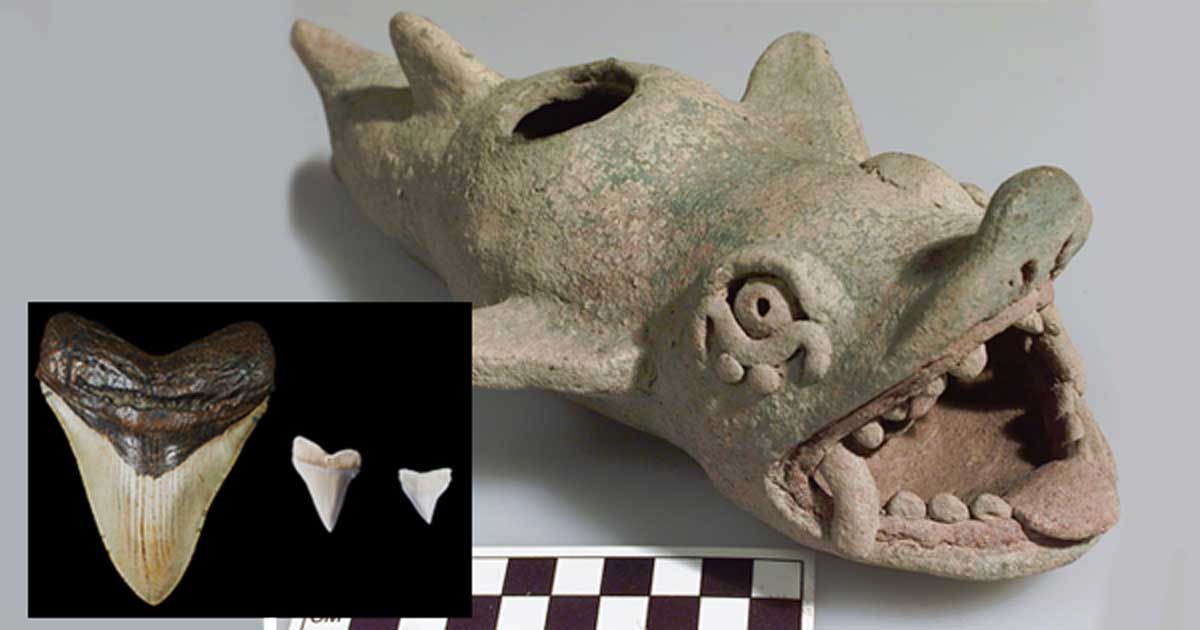
This betrays the fascination the ancient Maya had with these amazing sea creatures. An archaeologist has recently speculated that the graphic symbols may have been influenced by real encounters with sharks, as well as a lively trade in shark jaws and giant shark tooth fossils.
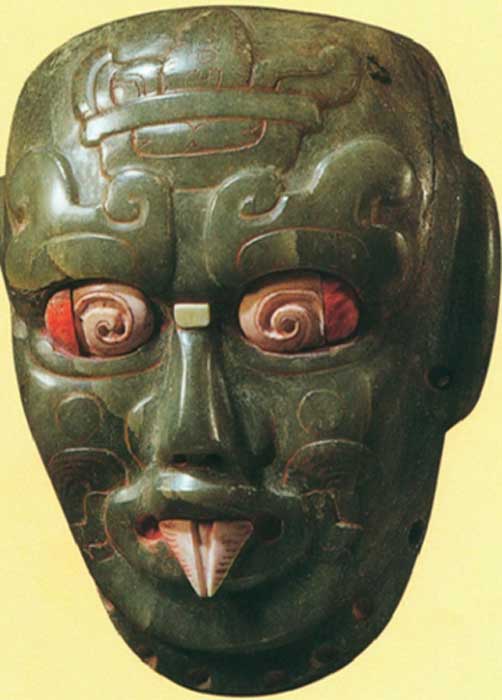
A Maya jade mask with a shark tooth from a tomb in Rio Azul, Peten, Guatemala. ( Milan Kováč )
The Many Uses of Shark Teeth
It is pretty common for archaeologists to discover shark teeth at Mayan sites, with some of them dating from 100 AD. What never fails to surprise them, however, is the various uses the artifacts had in every-day life: some were worn as pieces of elaborate jewelry; others were attached to sharp weapons and some were even used in gruesome bloodletting rituals.
Sea creatures with shark-like features also appear on decorative pottery and the walls of ceremonial buildings. Moreover, an ancient Maya creation story glorifies the Maize God destroying a shark in a bloody battle. But what made this graceful yet vicious sea animal such an important cultural figure in the ancient Mayan civilization?
James Madison University archaeologist Sarah E. Newman provides a simple answer in the journal Antiquity – the coastal Maya peoples hunted sharks. It’s possible that traders from coastal cities traveled to the interior with shark teeth and jaws, spreading urban legends about the intimidating sea creatures.
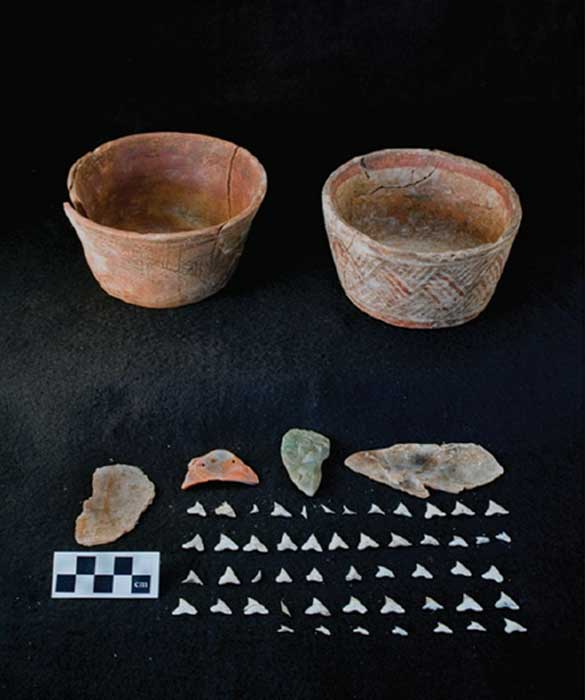
Late Classic (c. AD 650–750) cache from El Zotz, Petén, Guatemala, showing two polychrome vessels, two muscovite mica plates, a carved greenstone figurine, a Spondylus shell pendant and the upper teeth of a requiem shark, probably all from a single individual. Photograph by Stephen Houston. ( Sarah E. Newman )
Ars Technica reports that Newman suspects that just as these stories were passed by word of mouth, shark teeth were also possibly passed from trader to trader on their way inland – rather than being transferred directly from the same person who hunted them. This way, inland city residents didn’t have any real-life experience with sharks, but imagined them as ferocious beasts based on what they had heard from others.
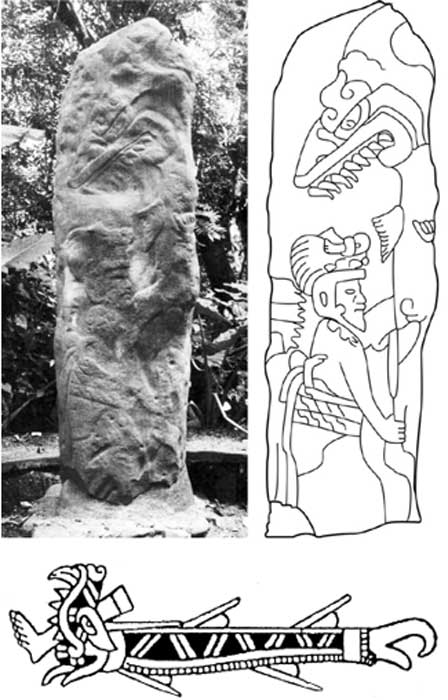
Top: Olmec Monument 63 in the archaeological site of La Venta, Mexico. ( University of Alabama ) and drawing detailing a person with a possible shark on the pillar. ( Clark et al. 2010: fig. 1.7c ) Bottom: Depiction of a shark with a human foot sticking out of its jaws in the Aztec Codex Fejérváry –Mayer, plate IX, No. 42. ( José I. Castro )
She writes in Antiquity:
“The correlation between iconography and artifacts raises the possibility that only the upper jaws of sharks, prized for their cutting edges, were transported inland. Indeed, it is possible that the Maya of the interior jungles never saw a complete pair of shark jaws, only the upper half.”
Perhaps that explains the mythical status of the formidable sea creature in most inland Mayan cities.
The Divine “Xook”
In Classic Mayan writing, the logograph for shark is “xook” (often portrayed as having a single, large tooth) or “xoc,” pronounced “shok.” There were plenty of symbolic conventions in local culture when it came to representing this. Most often xook was depicted as a powerful deity. Newman explains ,
“Classic Maya rulers associated themselves with the powerful, semi-divinity of sharks by incorporating the creatures into their names, such as Tikal’s dynastic founder, Yax Ehb Xook (“First Step Shark”) and Ix K’abal Xook (“Lady Shark Fin”), an eighth-century queen of Yaxchilan.”
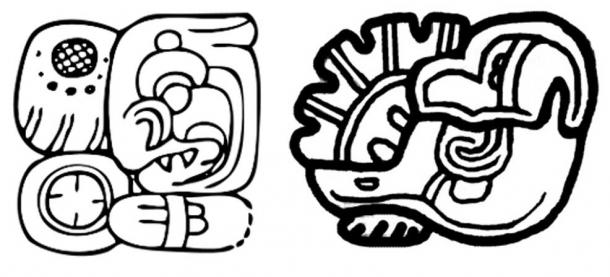
Left: the “signature” glyph of Ha’ K’in Xook. ( Public Domain ) Right: The glyph of Yax Ehb’ Xook, dynastic founder of Tikal. (Mabarlabin/ CC BY SA 3.0 )
As for the common depictions of xook with a single, large tooth, Newman observed that enormous fossilized teeth from Megalodon have been found in many Maya sites. The Megalodon was a prehistoric shark which dominated the seas that encroached on Mexico and Central America millions of years ago. It’s quite possible that the natives of those areas unearthed these teeth at some point and imagined a terrifying xook sea monster with a single, huge tooth.
Newman provides a famous example of this depiction:
“At El Zotz, one of three versions of the Maya Sun God displays a shark tooth as his central incisor, with droplets of blood falling from his mouth. This nocturnal, blood-drinking Sun God sinks into the ‘fiery pool’ of the western sea at sunset. The sanguine droplets flowing from his mouth and the sunset-red, salty sea highlight an association between the strong saline taste of both fluids, perhaps another allusion to the Cipactli myth in which the great sea monster is speared and slain, making the ocean a realm of blood, violent conflict and dangerous beasts.”
Did the Maya Identify These Cenozoic Animals?
Newman’s study could change history as we know it. If you accept her theory that these images of single-toothed monsters were influenced by the discovery of Megalodon fossils, that would mean the Mayas were among the first peoples – if not the first – on our planet to identify these Cenozoic beasts. Newman writes , “It would be almost a millennium before Europe’s burgeoning biologists would similarly tie Megalodon teeth from Malta, known as ‘tongue stones,’ to large sharks from the distant past.”
The question remains if enough evidence will be found in the future to verify that these xook “sea monsters” are among the earliest examples of paleontological speculation in the world, or not.
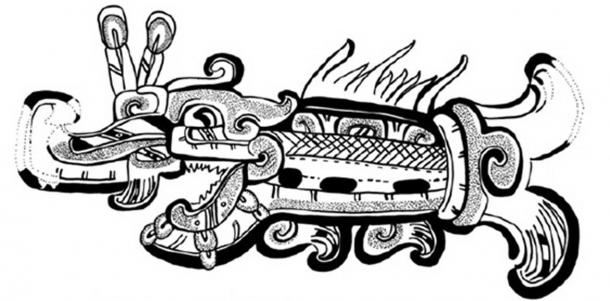
An Early Classic tetrapod plate shows a highly-stylized version of a shark, emphasizing a single, central tooth. Drawing by James Doyle. ( Sarah E. Newman )








